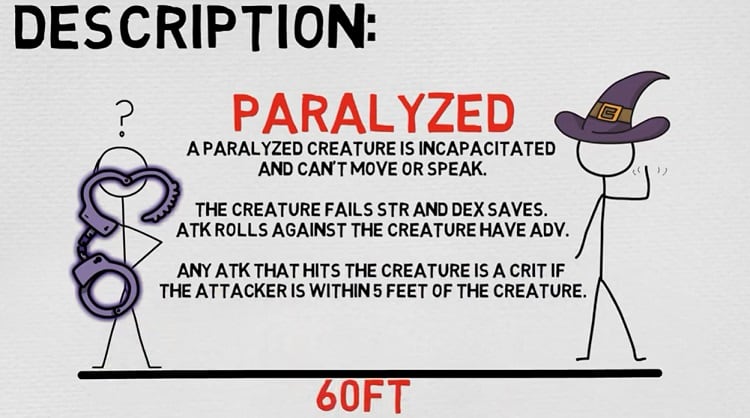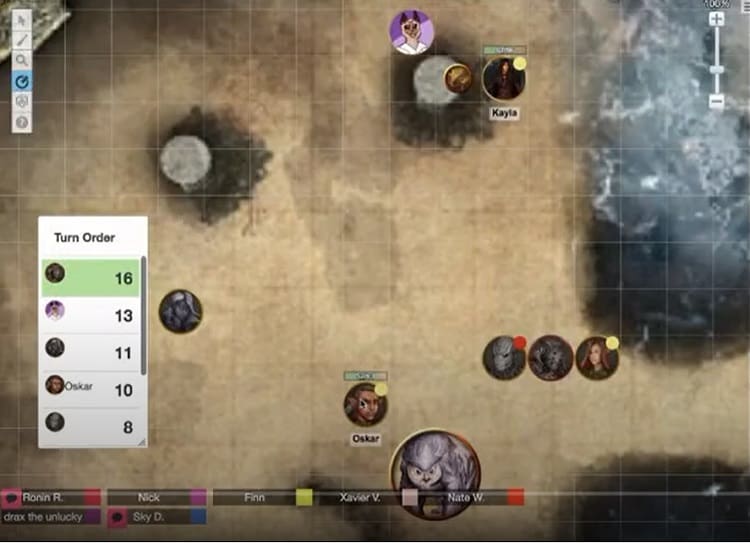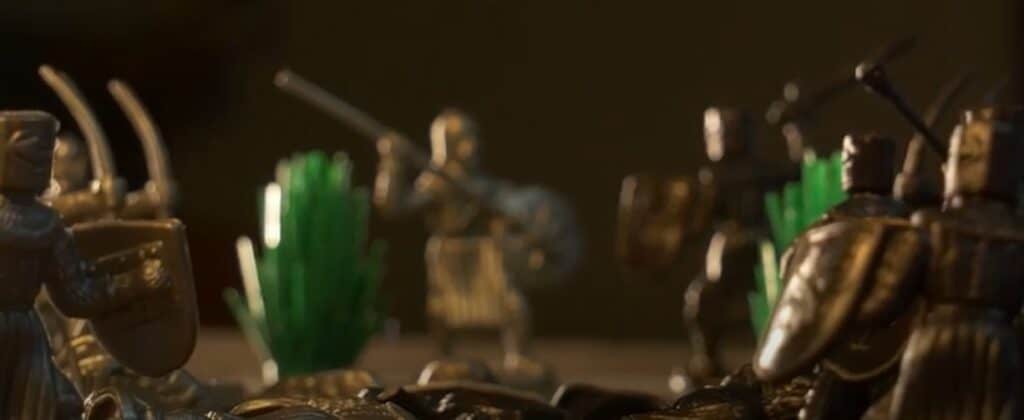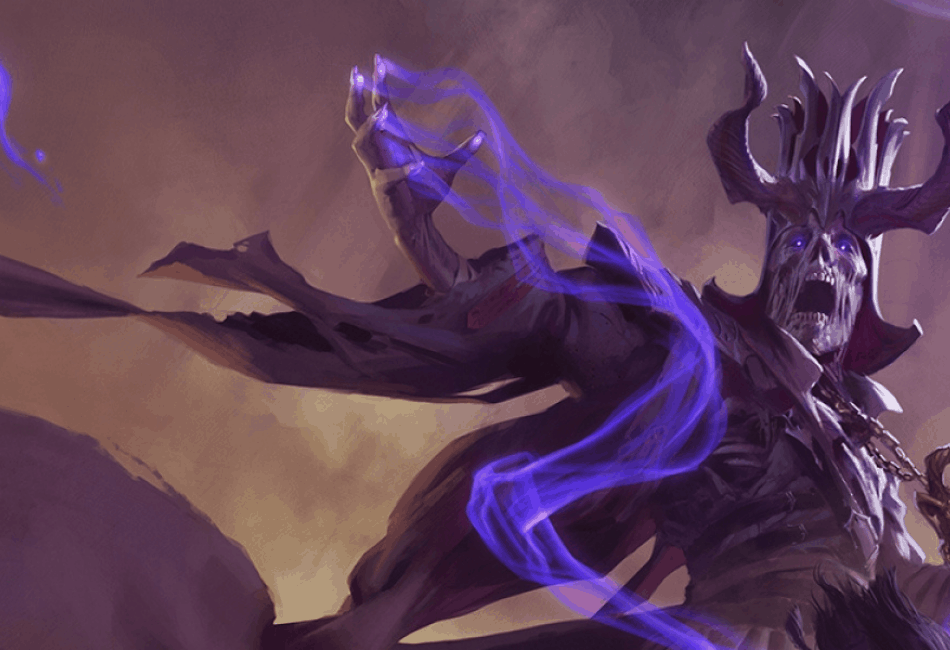It’s D&D night and your barbarian cartoons head first into the room with no concern for the rest of the party or what’s on the other side. A hooded figure stands up from their desk in the room and casts a spell.
The DM asks you to make a Wisdom saving throw. You roll a 2 and fail. Suddenly, your barbarian feels their muscles contract and tenses up and as you swing down your greataxe on the figure, you find yourself frozen in place, completely paralyzed.
What kind of powerful spell did this enemy cast? How powerful a spellcaster must you be to completely disable a foe like this? How can you treat enemies with the same extreme prejudice? The answer is: Hold Person.
Welcome to a Hold Person 5e Guide.
The Spell
Hold Person is a 2nd level enchantment spell that allows you to magically paralyze a humanoid for up to 1 minute. Let’s have a look at exactly how this works.
It has a casting time of 1 action and a range of 60 feet. In order to cast it, the spell requires verbal, somatic, and material components. Therefore, you must be able to speak, have a free hand, and have either the necessary components or some kind of focus. The spell’s duration is concentration, up to 1 minute.
When you cast this spell, choose a humanoid that you can see within 60 feet of you. That target must make a Wisdom saving throw against your spell save DC (8 + your proficiency bonus + your spellcasting modifier). If they get less than the DC, they are paralyzed.
At the end of each of its turns, the target can make another Wisdom saving throw to end the spell. If they succeed, the spell ends and they are no longer paralyzed.
Casting at Higher Levels
When this spell is cast at a higher level than 2nd, you can target one additional humanoid for every additional level of the spell. For example, if you cast this spell at 5th level, you can target a total of four humanoids. However, they must be within 30 feet of each other.
When you target additional people, they each make a Wisdom saving throw independently of each other.
The Paralyzed Condition
Why is this spell good? To answer that, we need to look at the paralyzed condition that you inflict on your enemy if they fail their saving throw.
A paralyzed creature suffers from the following effects:
- They are incapacitated and cannot move and speak.
- They automatically fail Strength and Dexterity saving throws.
- Attack rolls against them have an advantage.
- Any attack that hits them is a critical hit if the attacker is within 5 feet of them.
Firstly, a creature that is incapacitated cannot take actions or reactions. If they were previously concentrating on a spell, their concentration ends.
Secondly, if you or an ally follow up this spell with a spell that requires a Strength or Dexterity saving throw such as a Fireball, the paralyzed enemy will automatically fail. Finally, attacks against a paralyzed creature are made with advantage and a hit within 5 feet scores a critical hit.
This makes the spell incredibly deadly when you have a fighter, rogue, or a paladin in your party. Cast this spell against an enemy and, if they fail their saving throw, send a melee ally in to score as many critical hits as they can.
A fighter can use an action that arises to gain another action, a rogue’s critical doubles their sneak attack damage, and a paladin can double the damage from their divine smites.
Therefore, failing a saving throw against this spell will lead to an enemy’s swift death as your entire party unloads as much firepower as necessary.
The Limitations

This spell can be a death sentence for your enemies. Why is something so powerful only a 2nd level spell? There are a few clear limits to the spell that make it appropriate for a 2nd level spell.
Save-or-Suck
The first is that the spell is considered a “save-or-suck” spell. This means that if your enemy succeeds on their Wisdom saving throw, absolutely nothing happens.
Compare this to the 1st level spell Thunderwave. Thunderwave deals 2d8 thunder damage and pushes enemies 10 feet back. If your targets succeed on their saving throw, they aren’t pushed back but they still take half the amount of damage.
“Save-or-suck” spells are given this name because the effect is more powerful than other spells of the same level, an enemy can’t be partly affected. Make the saving throw or it sucks to be them. Save or suck.
When you cast a save-or-suck spell and the target succeeds, no effect takes place but you still expend the spell slot used to cast the spell. As a caster, using one of your most valuable resources on your turn and nothing happening can be incredibly frustrating.
Therefore, casting a spell like Hold Person can be totally debilitating to an enemy team but it is a greater gamble than casting a different 2nd level spell that deals damage no matter what.
Repeated Saving Throw
The second half of the spell’s description says that the target can make another Wisdom saving throw at the end of its turn. This means that if the target fails the initial saving throw, they will immediately be paralyzed, but might break out of it one round later.
When you cast this spell, don’t expect to be able to paralyze someone for an entire minute. Even spending one round paralyzed can be a death sentence since melee attacks score critical hits.
Humanoids Only

The second limit to this spell is that it only affects humanoids. What does that mean, exactly? There are fourteen creature types in D&D. These are used to categorize the monsters you might encounter.
Some spells, class features, and magic weapons have a greater effect on some types while some creature types might be completely immune to a certain feature.
The ‘humanoid’ creature type is only one of these fourteen types. Therefore, this spell only works against a fraction of the monsters you will encounter as an adventurer. Common monsters that are humanoids are:
- Goblins, hobgoblins, and bugbears
- Most playable races including Drow
- Kobolds
- merfolk
- Gnolls
- Orcs
- Lycanthropes
Typically, adventures will feature many more humanoid creatures at lower levels when being ambushed by bandits or clearing out a goblin hideout is a challenge. At higher levels, humanoid enemies can be rarer but this depends on your DM’s style.
If you want to be able to paralyze any creature type, you’ll need to use the spell Hold Monster, which can target anyone. However, you’ll be waiting a while as this spell is a 5th level spell.
Concentration
The last limitation is that this spell requires your concentration. This means that in order for your target to stay paralyzed, you must maintain concentration on the spell. You lose concentration on the spell if you are incapacitated, take damage and fail a concentration check, or if you cast another concentration spell.
Therefore, you cannot cast another ongoing area effect spell like Spike Growth while concentrating on this spell. You can, however, cast non-concentration spells on your following turns.
Who Can Use This Spell?

Hold Person is a spell available to:
Since all of these classes are full spellcasting classes, they will be able to cast this when they gain 2nd level spell slots when they reach 3rd level in their class.
Making the Most of Hold Person
While the spell itself is quite powerful, it doesn’t do the job all by itself. Using this spell requires a plan. When you cast this, here are a few ways to ensure its efficacy.
- Pay attention to the initiative. If the person you’re targeting has their turn directly after you, they will effectively get two saving throws to break out of the paralysis. While it’s still nice for them to have lost a turn, the real power of this spell relies on following up with damage.
- Target enemies near allies. If you paralyze an enemy that your fighter is already hitting, they won’t have to move across the battlefield to attack your target.
- Don’t target minions. If a battle includes many smaller enemies with fewer hit points, a critical hit against them might not be worthwhile as targeting the boss monster.
- Tell your party who to go after. If no one in your party is near an enemy, tell them what you’re going to do. It can be very tempting to keep your badass move to yourself to surprise everyone. However, communication makes an effective team. Tell your friends at the table what you plan to do and what they should do to make the most of it. Then, after your party has scored ten critical hits against the boss, you can enjoy your badassery. Don’t be afraid that your DM will try to thwart your plans. Good DMs want you to succeed and want your plans to work.
- Play the divination wizard. Even though this spell is an enchantment spell, you can get the most out of it using the divination wizard’s portent rolls. If you roll a low number, you can cast this spell and prescribe your low roll to the Wisdom saving throw and have your enemy automatically fail.
FAQs
Question: Is Hold Person a Cleric Spell?
Answer: Yes, this spell is on the cleric spell list.
Question: Do You Get Advantage on Hold Person?
Answer: Once you’ve paralyzed your enemy, all attack rolls against them are made with advantage, and attacks made within 5 feet that hit score a critical hit.
Question: Is Hold Person a Good Spell?
Answer: Hold Person can be an incredibly powerful spell to take. You’ll need to make sure you follow it up with at least one attack and at higher levels, you might not encounter the many humanoid enemies.
In this case, you’ll want to swap it out for something else. Clerics and druids are able to change out their entire spell list, making this much easier for them.
Question: Does Hold Person Stop Rage?
Answer: The barbarian’s rage ends if they fall unconscious or if you have not Been Attacked or Attacked. Hold Person stops you from attacking. However, if you are attacked and take damage, your rage continues.
Question: Can You Talk with Hold Person?
Answer: No. A paralyzed creature cannot move or speak.
Hold Person 5e Guide: Summary
Hold Person is a 2nd level spell available to many spellcasters in D&D 5e. You target a creature who makes a Wisdom saving throw against your spell save DC. If they succeed, nothing happens. If they fail, they are paralyzed.
While paralyzed, they lose concentration, are incapacitated, and cannot move or speak. All attacks against them are made with advantage and attacks made within 5 feet that hit score a critical hit. The target gets to repeat the saving throw at the end of each of their turns.
By itself, this spell can take a creature out of combat for at least one round. However, if you follow this spell up with a sneak attack, action arises, or smite, you can deal an absurd amount of damage in one round. Target powerful enemies and kill them in the first round of combat. Just pray that they don’t have Counterspell.
- Armor of Agathys 5e Guide: What is Armor of Agathys? - August 3, 2022
- Oath of the Ancients 5e Guide - August 3, 2022
- Dissonant Whispers 5e Guide - July 20, 2022

